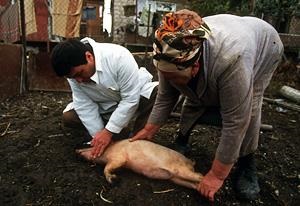
21 August 2012, Rome - Following the first-ever detection of African swine fever in Ukraine, FAO is warning that while control measures appear to have temporarily halted the disease's spread, it has established a firm foothold in the Caucasus and poses an ongoing risk to neighbouring areas.
In addition to some other parts of Ukraine, nearby countries like Moldova, Kazakhstan and Latvia — which have large pig populations raised on household or family farms, and oftentimes weak biosecurity protocols — are also now at high risk of disease introduction.
"National and local authorities in the entire region should scale up their prevention measures and be ready to respond in case of further outbreaks," said Juan Lubroth, FAO's Chief Veterinary Officer. "This could be the first of more outbreaks to come, according to our disease analyses."
African swine fever (ASF) doesn't affect humans, but mortalities in domestic pigs can be extremely high.
In 2011, up to 300 000 pigs died or were culled as a result of ASF outbreaks in the Russian Federation, incurring an estimated $240 million in economic losses.
Early detection, rapid response
Ukraine has responded quickly, implementing sanitary measures, destroying affected pigs and imposing a quarantine zone around the village where the outbreaks occurred, according to Lubroth.
Most importantly, Ukraine has paid farmers compensation for pigs that were slaughtered and properly disposed of, so that poor families that depend on pig raising for food and income aren't left ruined by the loss of their pigs, he said.
All countries at risk should stand ready to detect any ASF outbreaks as soon as they occur and respond in a similarly proactive fashion, according to FAO.
Human activity contributes to spread
ASF is caused by a highly infectious virus that affects domestic pigs and wild pig species.
Humans often contribute to its spread, even via what would seem a harmless discarded sandwich. Foodstuffs that contain ASF-contaminated pork or pork products, such as cured meats, can be consumed by scavenging free-ranging pigs, kept by many vulnerable families in the region for income and their own household food needs. These pigs can be exposed by feeding on contaminated food among refuse, by consuming improperly disposed pig carcasses and pork parts that are infected or if they eat a discarded ham sandwich that contains the virus.
As a result, ASF can spread by leaps and bounds when it is introduced to new areas.
Prior to being introduced to the Caucasus in 2007, it had been confined for several decades to the African continent and the Italian island of Sardinia. Today, however, it is considered endemic in parts of the Russian Federation and some countries in the Caucasus region, including Georgia and Armenia. It was eradicated from the Iberian Peninsula in the mid 1990's after decades-long work between the veterinary services and swine producers.
"Swill feeding" should be avoided
FAO has continuously recommended a strict ban on "swill feeding," in which various food scraps and leftovers are fed as a mix of liquid and solid food to domestic pigs.
FAO studies on ASF in the Russian Federation indicate that swill feeding is responsible for 97 percent of all new infections in domestic pigs. The backyard sector, which accounts for 34 percent of the entire domestic pig population, is typically infected first before subsequently passing the virus on to small commercial farms and eventually industrial farms.
Bans on swill feeding can be challenging to enforce in resource-poor settings, where swill feeding is a low-cost option for feeding pigs.
Role of wild boar
European wild boar are also susceptible to African swine fever, making them a vector for transmission as they wander freely across national boundaries.
According to FAO's mapping of wild boar populations in Europe, there is cause for concern: moving westward from the Caucasus region, wild boar populations steadily increase and become particularly dense in countries such as France, Italy and Spain. The number of domestic pigs likewise increases significantly moving westward from the Russian Federation, with Poland, Hungary and Germany marking the outer limits of large-scale commercial farming that exists throughout Western Europe.
ASF will be that much more difficult to combat as it finds a convenient host in dense populations of susceptible species, both farmed and wild pigs.
For more information about the signs and clinical findings of African swine fever, please consult the FAO field manual: Recognizing African Swine Fever.